
The Atari XE Video Game System is an industrial redesign of the Atari 65XE home computer and the final model in the Atari 8-bit computer series. It was released by Atari Corporation in 1987 and marketed as a home video game console alongside the Nintendo Entertainment System, Sega's Master System, and Atari's own Atari 7800. The XEGS is compatible with existing Atari 8-bit computer hardware and software. Without keyboard, the system operates as a stand-alone game console. With the keyboard, it boots identically to the Atari XE computers. Atari packaged the XEGS as a basic set consisting of only the console and joystick, and as a deluxe set consisting of the console, keyboard, CX40 joystick, and XG-1 light gun.

A type-in program or type-in listing was computer source code printed in a home computer magazine or book. It was meant to be entered via the keyboard by the reader and then saved to cassette tape or floppy disk. The result was a usable game, utility, or application program.

Compute!, often stylized as COMPUTE!, was an American home computer magazine that was published from 1979 to 1994. Its origins can be traced to 1978 in Len Lindsay's PET Gazette, one of the first magazines for the Commodore PET computer. In its 1980s heyday, Compute! Covered all major platforms, and several single-platform spinoffs of the magazine were launched. The most successful of these was Compute!'s Gazette, which catered to VIC-20 and Commodore 64 computer users.
Newsfield Publications Ltd was a British magazine publisher during the 1980s and early 1990s.

The One was a video game magazine in the United Kingdom which covered 16-bit home gaming during the late 1980s and early 1990s. It was first published by EMAP in October 1988 and initially covered computer games aimed at the Atari ST, Amiga, and IBM PC compatible markets.
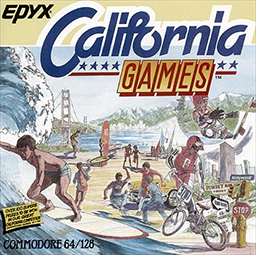
California Games is a 1987 sports video game originally released by Epyx for the Apple II and Commodore 64, and ported to other home computers and video game consoles. Branching from their Summer Games and Winter Games series, this game consists of a collection of outdoor sports purportedly popular in California. The game was successful and spawned a sequel, California Games II.

The Atari XG-1 light gun is a video game controller which was released in 1987. Atari's only light gun, it is compatible with the Atari 8-bit computers, Atari 7800, and Atari 2600. It was bundled with the Atari XEGS Deluxe home computer and video game console combination system, and with the light gun game Bug Hunt for the 7800 as model XES2001 for US$34.95. Atari eventually released five light gun games on the 7800 and one on the 2600 (Sentinel).

Atari ST User was a British computer magazine aimed at users of the Atari ST range. It started life as a pull-out section in Atari User magazine. From April 1987<http://www.atarimania.com/mags/hi_res/atari-st-user-vol-02-issue-02_5.jpg volume 2 issue 2</ref> onwards it became a magazine in its own right, outliving its parent by a number of years. It was published initially by Database Publications in Stockport, and later by Europress in London.
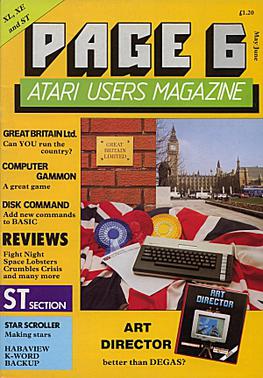
Page 6 was a British magazine aimed at users of Atari 8-bit computers and Atari ST home computers. The first issue was in 1982, and it was renamed to Page 6 Atari User and then New Atari User before ceasing publication in 1998.

Amstrad Computer User was the official magazine for the Amstrad CPC series of 8-bit home computers. This monthly publication, usually referred to as ACU by its readers, concentrated more on the hardware and technical side of the Amstrad range, although it had a small dedicated games section as well.
Atari Corporation was an American manufacturer of computers and video game consoles. It was founded by Jack Tramiel on May 17, 1984, as Tramel Technology, Ltd., but then took on the Atari name less than two months later when Warner Communications sold the home computing and game console assets of Atari, Inc. to Tramiel. Its chief products were the Atari ST, Atari XE, Atari 7800, Atari Lynx and Atari Jaguar.

Antic was a print magazine devoted to Atari 8-bit computers and later the Atari ST. It was named after the ANTIC chip in the 8-bit line which, in concert with CTIA or GTIA, generates the display. The magazine was published by Antic Publishing from April 1982 until June/July 1990. Antic printed type-in programs, reviews, and tutorials, among other articles. Each issue contained one type-in game as "Game of the Month." In 1986, STart magazine was spun off to exclusively cover the Atari ST line.

ANALOG Computing was an American computer magazine devoted to Atari 8-bit computers. It was published from 1981 until 1989. In addition to reviews and tutorials, ANALOG printed multiple programs in each issue for users to type in. Almost every issue included a machine language video game—as opposed to Atari BASIC—which were uncommon in competing magazines. Such games were accompanied by the assembly language source code. ANALOG also sold commercial games, two books of type-in software, and access to a custom bulletin-board system. After the Atari ST was released, coverage of the new systems moved to an ST-Log section of the magazine before spinning off into a separate publication under the ST-Log name.
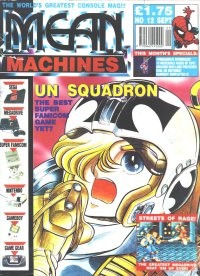
Mean Machines was a multi-format video game magazine published between 1990 and 1992 in the United Kingdom.
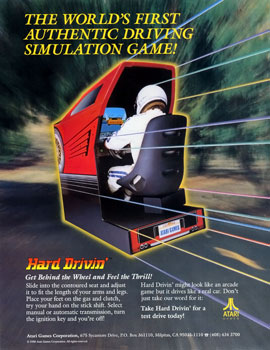
Hard Drivin' is a sim racing arcade video game developed by Atari Games in 1989. Players test drive a sports car on courses that emphasize stunts and speed. It features one of the first 3D polygon driving environments via a simulator cabinet with a haptic vibrating steering wheel and a custom rendering architecture.
ST Writer is a word processor program for the Atari ST series of personal computers. It was introduced by Atari Corporation in 1985 along with the 520ST, the first machine in the ST family. It is a port of Atari's AtariWriter Plus from the earlier 8-bit computer series, matching it closely enough to share files across platforms unchanged. Running on the ST allowed it to display a full 80-column layout, create much larger files, and support additional features.
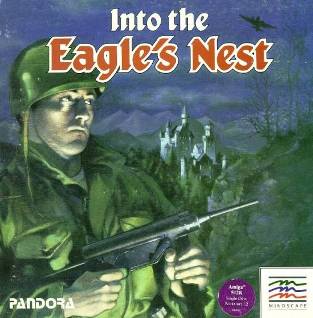
Into the Eagle's Nest is a video game developed by Pandora and published for Amiga, Amstrad CPC, Apple II, Atari 8-bit computers, Atari ST, Commodore 64, IBM PC compatibles, and ZX Spectrum starting in 1987.
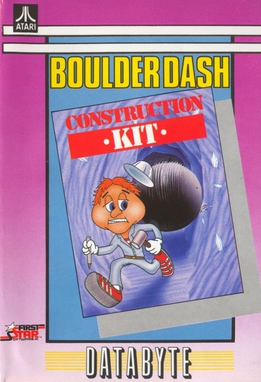
Boulder Dash Construction Kit is the fourth game in the Boulder Dash series. It published for the Commodore 64 and Atari 8-bit family in 1986 by Epyx. Ports were released for the Apple II, Atari ST, Amiga, Amstrad CPC, ZX Spectrum, and MS-DOS. The Spectrum version was rereleased as Boulder Dash IV: The Game. Boulder Dash Construction Kit includes new levels and a level editor.
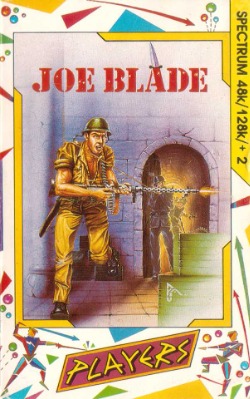
Joe Blade is a game published by Interceptor Micros on their Players budget label for the ZX Spectrum, Commodore 64 and Amstrad CPC in 1987. It reached the top of the UK game charts, replacing Renegade. In Germany, the game peaked at number 7. It was later ported to the Acorn Electron, BBC Micro, Atari 8-bit, MSX, Amiga and ST and a sequel, Joe Blade 2, was published in 1988. Another sequel, Joe Blade 3, was released in 1989.
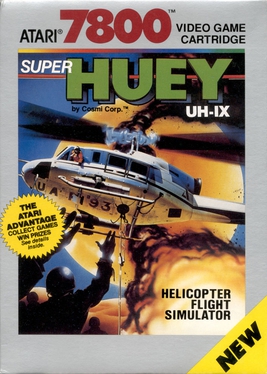
Super Huey UH-IX is a helicopter combat flight simulation game published by Cosmi Corporation. Originally released for the Commodore 64 in 1985, it was ported to the Amiga, Apple II, Atari ST, Atari 8-bit family, and MS-DOS. Atari Corporation published an Atari 7800 version in 1989.

















